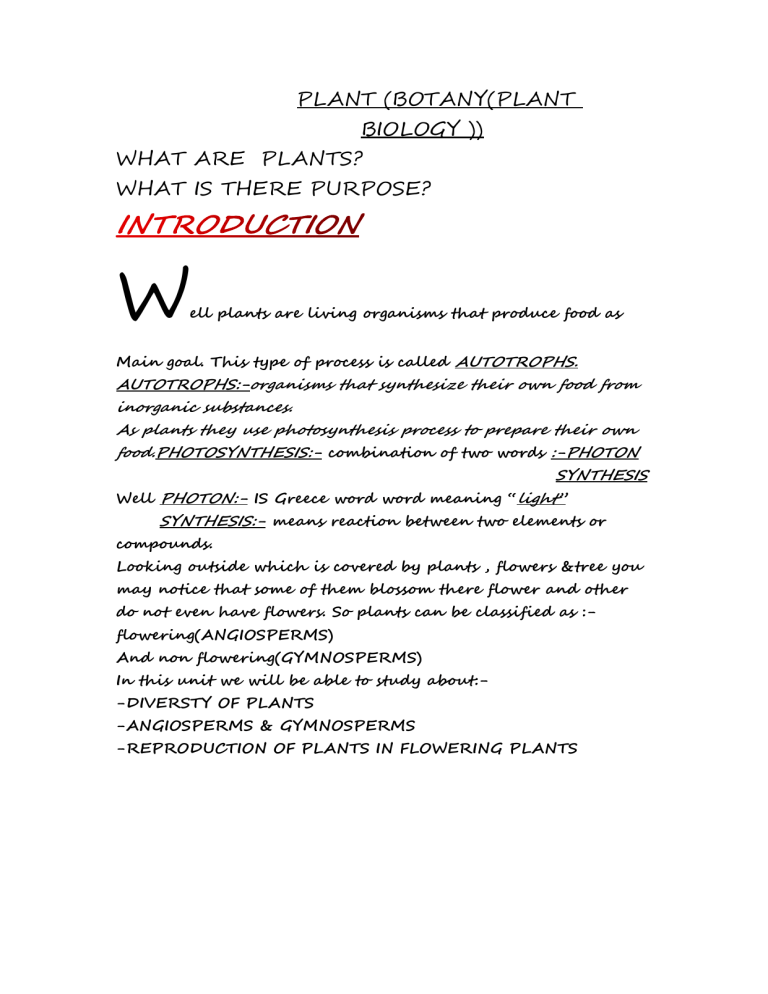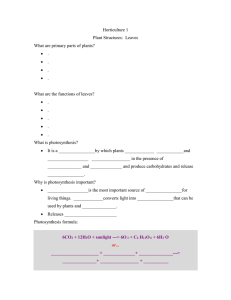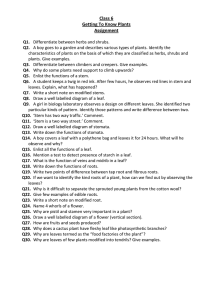
PLANT (BOTANY(PLANT BIOLOGY )) WHAT ARE PLANTS? WHAT IS THERE PURPOSE? W ell plants are living organisms that produce food as Main goal. This type of process is called AUTOTROPHS. AUTOTROPHS:-organisms that synthesize their own food from inorganic substances. As plants they use photosynthesis process to prepare their own food.PHOTOSYNTHESIS:- combination of two words :-PHOTON SYNTHESIS Well PHOTON:- IS Greece word word meaning “light” SYNTHESIS:- means reaction between two elements or compounds. Looking outside which is covered by plants , flowers &tree you may notice that some of them blossom there flower and other do not even have flowers. So plants can be classified as :flowering(ANGIOSPERMS) And non flowering(GYMNOSPERMS) In this unit we will be able to study about:-DIVERSTY OF PLANTS -ANGIOSPERMS & GYMNOSPERMS -REPRODUCTION OF PLANTS IN FLOWERING PLANTS P LANTS vary in size,where they live I.e. in the ground water bodies so on.plants from mosses (< 7cm) to the biggest tree Like General Sherman Tree(>100m) differ. In size. Alge is plant living in water bodies using photosynthesis. P lants not only differ in there size,and where they live They also differ in the present & absence of flowers where the flowering plants are also called angiosperms where the non flowering are called gymnosperms. Now days as science & botanists discovery there about 390,000 species of plants. Above 90%(352,000) are flowering plants or angiosperms the main use of the flowers are for sexual reproduction or flower is the structure for reproduction and creation of seeds & fruits. Thus, flower reproduction covers the largest production of seeds and fruits comparing to gymnosperm plants. Cones that are found in gymnosperm plants are structure for reproduction. Plants in different places differ? Well, yes b/c Altitude(high&lowland) climate(polar,moderate,tropical), Soil type,fertility&wetness to dryness(sand,clay,loam) This difference make plant to live in different places,climate, Altitude. A s we know >90%of discovered plants are flowering plants. There property is differ from there nonflowering For instance :-they have flowers as reproductive structure -have seeds and fruits where the seed is inside the fruit to make the seed wet. -use different agents to pollinate (wind,insects like bees) POLLINATION AGENTS:- it is an agent which is involved in transfer of pollen grains. POLLINATION:- the process of transfer of pollen grains. MAIN PARTS OF ANGIOSPERM PLANTS We know that many plants have leaf,steam,branch,roots as main part of plant. We know root that is under the ground or it is found in the soil so, it helps the plant for photosynthesis process indirectly. As steam it holds the plant up right . leaf for photosynthesis is used mainly. SHOOT SYSTEM:- the above ground part of plant, Including steam Leaves Flower ROOT SYSTEM:-the underground part of plant, including -main root -lateral root -root hairs -root cap STEM THE stem is the part of plant that is found above the soil or ground. This part of plant is classified in to two:non woody(herbaceous) Woody Main function of stem - transporting water &minerals from root to other parts of plants -holding the shoot system parts upright -Transporting photosynthetic materials from leaf to other parts LEAVES This are the esenical part of plant that are involved in photosynthesis process to produce their food. They store their food as a starch. MAIN IMPORTANT OF LEAVES -carry out photosynthesis to make food -Gaseous exchange -water loss -store food MAIN PARTS OF LEAVES The leaf is made of tissue which are sandwiched between 2 tough layers namely lower and upper epidermis. EPIDERMIS:-the outer layer of tissue in a plant. -Commonly the leaf has blade or lamina or the board of leaf part. -The petiole or the leafstalk is soft steam like that connects to the main steam. -It has epidermal layers that protects the leaf from insects and pests. -Among the epidermal cells there is sausage-shaped guard cell. -Each pair of guard cell from pore called stoma or as plural stomata. -gases enters and exits through stomata -most food production takes place in the photosynthetic cell which is also known as mesophyll tissue. -the leaf is mainly is made up of the green pigmet which is also known as chloroplast. THE ROOT AND ITS SYSTEM The root is the important part of the plant that is found underground and fixes it to the soil to absorbs minerals and water. Main function of roots:-Absorbs water and minerals and transport materials to the plant -Food storage -Removing unwanted material from the plant -Communicating to other plants through there roots. Main external and internal features of the root The root system contains:-The main (primary) root:- the main root that first grow from the base of the plant. -Lateral roots:-secondary roots that is the branch of the main root. -Root hairs :-very fine root that appears like hair branching from lateral or main root. -Root tip:-the part of the root which is growing downward into the soil. -Root cap:- a very tough part of the root which protects the growing region of the root tip. Types of root system Mainly the root system is grouped in to two Tap root system:-a single central main root grows deep down ward into the soil and lateral branches developed sideways. In this root system :- the main root is wider in diameter And lateral roots are narrower A carrot root is best example for this root system Fibrous root system:-is type of root system which contains many smaller roots of similar diameters. Roots of corns are the best example for this root system Internal features of roots The outer layer of root is covered by epidermis where as the internal is covered by cortex. The transport components which is also known as vascular bundles contains the xylem and phloem. Vascular bundles :-food and water transporting tissue in higher plants. Cortex:- the outer layer of tissue immediately below the epidermis of root. Xylem:- vascular tissue that conveys water and dissolved minerals from the roots to the rest of the plant and also provides physical support. Phloem:-is the living tissue in vascular plants that transport the soluble organic compounds made during photosynthesis. Monocotyledons And Dicotyledon Cotyledon is leaf -like structure in seeds serving as stored food for embryo in seeds So, when we say mono and dicotyledon we are mentationing the number of cotyledon for mono:-1for di:-2 Monocots:-there about 65000 different species across the world For instance teff,maize,wheat,barley etc are mono in cots. Dicots:-there about 170000 different species in the whole world as discovery. Of example:- sunflower,beans,peas ANGIOSPERM plants are reproduced sexual and asexual. Sexual reproduction:-type of reproduction which two parents are involved as a union of gamete. Asexual reproduction:- type of reproduction only one parent involving with out the union of gamete. Vegetative propagation In asexual reproduction in plants there is no need of flowers and other reproduction structure. For the method only the vegetative part or body of plant is needed to produce there offspring. In asexual:-a single organism is involved There is no production of gamete Offspring produced are genetically identical Vegetative propagation can be artificial or naturally. Artificial Vegetative propagation:- this propagation is done by humans through cutting there stem,grafting,layering,etc Natural Vegetative propagation:- this process is done by the parent plant which is mainly involved through the steams like rhizomes,corms,suckers soon. Types of vegetative Propagation For instance, we will see 3 propagation but first lets see about buds. a small lateral or terminal protuberance on the stem of a plant that may develop into a flower, leaf, or shoot. 2 : something not yet mature or at full development: such as. a : an incompletely opened flower.is called buds. 1) stem cutting It it process in which the stem is cut down diagonally from the plant take to the soil and planted diagonally. This practice is done for many plant like:-rose,



